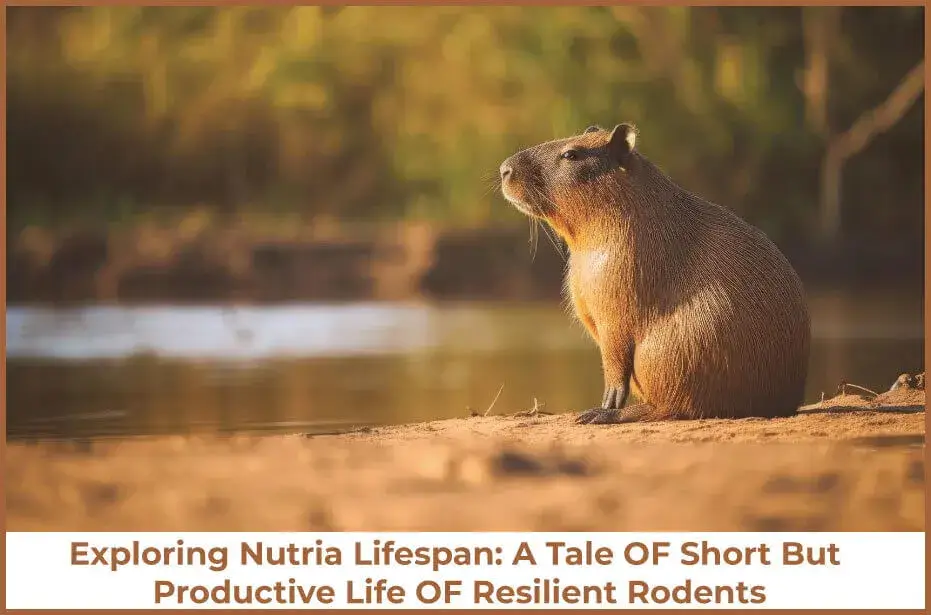Exploring Nutria Lifespan: A Tale OF Short But Productive Life OF Resilient Rodents

Have you ever had a chance to meet a creature that seems to incorporate the resilience and adaptability of nature in its soul? Imagine a creature that appears like a crossbreed of mice and beavers, with a unique appearance, and is partially aquatic. Yes, such hybrids exist in the form of Nutria, also known as water rodents or river rats. The locality of these swamp rats is South America and are considered partially-aquatic animals. From their unique appearance to their ability to live in a semi-aquatic habitat, these swamp rats have fascinated researchers and their admirers alike. One perspective that has captured the curious minds is the nutria lifespan.
Are Nutria Understanding Myocastor Coypus: An Overview Animals?
Let’s understand the appearance and classification of these river rats before delving deep into their lifecycle. Because of their partially aquatic nature, they can live on land and in water. They are also known
as coypu, meaning “Water Rodents.” These river rodents are a hybrid between rat and beaver, having rounded noses, webbed feet, and a long, thin tail. Because of their partially aquatic lifestyle, their fur provides insulation, and their shade varies from brown to reddish. Below is the classification that their admirers should know.
- Nutria belongs to the kingdom Animalia and has the species Chordate.
- The scientific name of Myocastor Coypus represents beaver and mouse.
- They belong to the subphylum Vertebrata and class Mammalia.
- Their order is Rodentia, and they have the family Myocastoridae.
- They have the genus Myocastor and the species of coypus.
These swamp rats are herbivores and mainly depend on aquatic plants, lawn grasses, tubers, and roots. Because of their adaptable nature, they can live in different habitats like rivers, lakes, and swamps. In many regions like the United States. They were introduced for fur farming in Europe, Asia, and South Africa. Most people claim these river rodents can be kept as good pets because of their affectionate behavior. It is advised to people who want to keep them as pets to ensure the availability of farms and pools.
Did You Know: The Coypus are nocturnal, which means they feed around midnight and rest during the day.
Exploring Nutria Lifespan
Different factors affect the lifespan of Myocastor coypus, and their average age is different when living in Captivity or the wild. Predators, habitat changes, diseases, environmental conditions, and parasites are some factors that can influence their average age and nutria health.

Nutria lifespan in the Wild
In the wild, the lifestyle of Coypus is challenging because of some problematic challenges like predators, diseases, and habitat fluctuations.
The Average age of Nutria living in the wild ranges from 3-6 years. According to scientific research, their annual mortality rate is 60-80%, and they don’t even get a chance to reach their third year after birth. Here are some factors that can influence their longevity.
Diseases And Parasites: Because they live in semi-aquatic habitats, exposure to this environment leads to different diseases and parasites. Leptospirosis & Tularemia (bacterial infection), Giardiasis & Cryptosporidiosis (parasitic disease), and parasitic worms are common illnesses these swamp rats can suffer.
Predators Threat: Alligators, snakes, birds, foxes, and many other predators want to prey on them and consider them as their tasty meal.
Environmental Changes: Extreme weather conditions could be deadly for these river rats, and changes in their habitat can disturb the food chain, which makes them vulnerable.
Did You Know: Myocastor coypus are considered good swimmers because of their webbed feet; they can swim and feed on vegetation at birth.
Nutria Lifespan in Captivity
Coypus living in Captivity in a safe and controlled environment have a longer and less stressful survival. In Captivity, their maximum age is 6 to 12 years. There are fewer chances of danger in Captivity than in natural habitats. Therefore, they live a little longer. The secret of a longer life in Captivity is their balanced and nutritious diet and stress-free environment. Because they have constant access to food and are protected from predators, they enjoy a longer and happier living in Captivity. It is observed that the lifespan of female Nutria doesn’t differ significantly from that of their male counterpart.
Did You Know: In 2004, Coypus were exterminated from their wildlife refuge on Maryland’s Eastern Shore with highly trained detector dogs.
Uncovering Size, Length & Weight Of The Nutria
The Myocastor coypus are relatively large rodents, but sometimes, people mistake them for large rats or more petite beavers. Below are the clarifications about their size, weight, and length.
- The length of an adult water rodent ranges from 40-60 centimeters.
- The average weight of a coypus is 4-7 kilograms, while some vast creatures range from 16-17 KG.
- The average height of these water rodents is about 21-30 centimeters.
Did You Know: Myocastor Coypus have poor eyesight; therefore, they recognize danger mainly through their hearing.
Summing Up!
It is essential to understand the nutria lifespan because it offers insight into the adaptability and resilience of these productive river rats. As prolific herbivores and prey animals, their existence is essential in wetland habitats. They have a unique appearance and affectionate behavior. These semi-aquatic river rats, or Myocastor Coypus, are considered a hybrid between mouse and beaver.
The lifespan varies depending upon their environmental conditions and habitat. In the wild, the average age is 3-6 years because of the different challenges of wild habitats, while the maximum age of living in Captivity is 6-12 years. Besides this, challenges like environment, predators, diseases, parasites, and habitat changes can influence their average lifespan.
The female coypus can give birth to 2-3 litters per year.
They get pregnant with a gestation period of about 132 days, which results in 1-12 offspring
The coypus get pregnant three times within a year.

